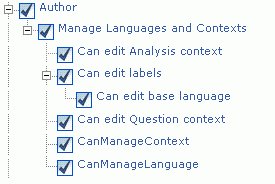Displaying a multiple-level application feature tree
By default, each application feature tree displays features at two levels. You can configure an application feature tree to display in multiple-levels. The following example demonstrates how to display the Author application feature tree at multiple levels:
1 Create an .xml file (for example, AppFeatureStructure.xml), that defines the application feature tree structure. For example:
<Application name="Author">
<Feature name="ManageLanguagesAndContexts">
<Feature name="CanEditLabels">
<Feature name="CanEditBaseLanguage"></Feature>
</Feature>
<Feature name="CanEditQuestionContext"></Feature>
<Feature name="CanEditAnalysisContext"></Feature>
<Feature name="CanManageContext"></Feature>
<Feature name="CanManageLanguage"></Feature>
</Feature>
<Application name="Author">
2 Put the .xml file in the [INSTALL_FOLDER]\spssmr\Author\bin directory.
3 Launch DPM Explorer, select Servers > Applications > Author > ApplicationSetttings, and add the following properties:
AppFeatureStructureFileName (value = AppFeatureStructure.xml)
AppFeatureStructureFolder (value = ../Author/bin).
Activity Feature Tree displaying at multiple levels
When you next launch the User Administration activity, the Author application feature tree looks like this:
See also

